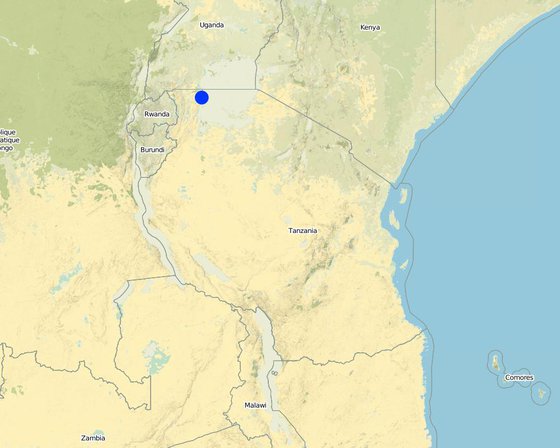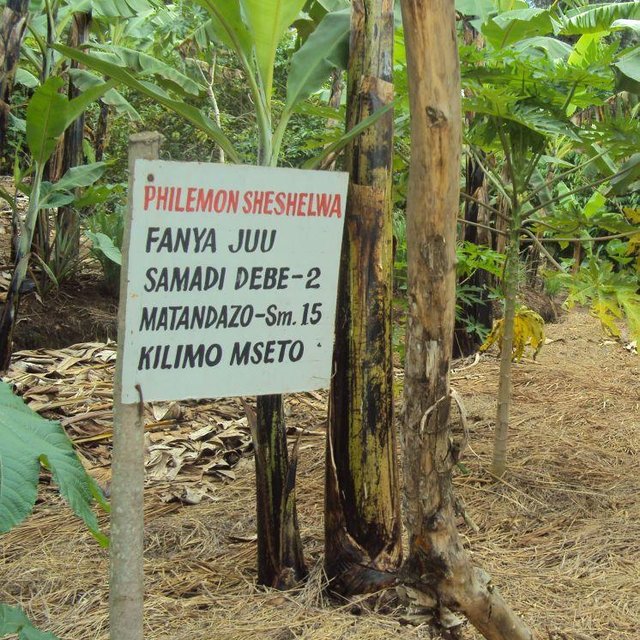

Contour band combined with lemon grass, pineapples, Hyperrhamia rufa mulch and manure technology in the banana production is the excavation of a 60cm deep by 60cm wide furrow and formation of soil embankment on upper side (at smaller slope) and lower side (at the greater slope) of the furrow to improve soil water infiltration; then planting on it with lemon grass and pineapples to stabilize soil embankment combined with spreading of a 15cm thickness grass mulch across the slope while 36kg of farm yard manure applied in a furrow measured 30cm deep by 60cm wide facing the grand daughter banana sucker at the distance of 60cm from the stool. Trushline is applied to complement grass mulch while lemon grass and pineapples are harvested routinely for sale.The technology is applied on perennial cropland characterised with sub humid in tropical climatic zone. The main biophysical features are gentle slope, clay loam soil with shallow depth. The technology done manually using hand hoes to cultivate land in a mixed (subsistence and commercial) production mode. To implement the technology, it costs US$ 220.00 for establishment and US$ 2,222.65 for maintenance costs. The technology was introduced in late 2012 by TAMP –Kagera using FFS methodology.
Purpose of the Technology: The major purpose of the technology is prevented land degradation in 50 ha while increased 10% of crop and livestock production to contribute on food security and improve livelihood with sustainable land management. This purpose should be achieved by performing the following main technical functions: control
of dispersed runoff, increase in organic matter, increase in nutrient availability (supply, recycling,…), increase of infiltration and increase / maintain water stored in soil.
Establishment / maintenance activities and inputs: The establishment activities includes:-First is identification and demarcation of contour lines done manually using the A-frame simple made tool, the activity normally done in May. Second is construction of contour bund along the identified and demarcated contour done manually using cheasle hand hoes, fork hand hoes, spades and mattock, this is done in early June. Third is Planting lemon grass and pineapples along the contour bund done manually by spacing 30cm plant to plant (grass lemon) while pineapples are planted at 5m alternating with lemon grass; this is done in early September.
The maintenance activities included:- First is farm weeding done manually using a simple made weeding tool (kahosho); this is done twice (January and June to August). Second is Farm yard manures application done manually using baskets, spades and fork hand hoes; this is done in July. Third is grass mulch application done manually by spreading dry Hyperrhamia rufa across the slope with a thickness of 15cm to cover space between the bunds planted with bananas; this is done in late September. Fourth is desukering and detrushing of banana stools done manually using machete, local made tools (kihosho and rwabyo); this is done twice (early March and early October). Then, harvesting bananas, lemon grass and pineapples according to market requirements. Last is furrow cleaning done manually by removing soil sediments and place them on the bund side using spades; this is done twice per year at the end of each rain seasons (May and December).
Natural / human environment: The contour bund embanked with lemon grass and pineapples technology is tolerant to seasonal rainfall decrease and droughts / dry spells. However the technology is sensitive to climatic seasonal rainfall increase, heavy rainfall events (intensities and amount). In case of climatic sensitivity, the technology should be modified with planting of perennial species having strong/ tough root system such as Pinesetum purperim and Vetiva spps to stabilize soil embankment. Furthermore the construction of spillways to drain-out the excess water and reseve them in the ditches to be used in the farms later. This technology is applied by Individual / household categorized as small scale common / average land users, with importance of men and women participating equally. The land is owned individually, not titled. The Water use rights is open access (unorganized). The relative level of wealth falls under three categories; the rich, which represents 4% of the land users; owning 32% of the total area; the average, which represents 64% of the land users owning 64% of the total area and the poor, which represents 32% of the land users owning 4% of the total area. Individuals who applied the technology should value the off-farm income as 10%. The market oriented is mixed (subsistence and commercial).

Location: Bukoba Diatrict council, Kagera region, Tanzania, United Republic of
No. of Technology sites analysed:
Spread of the Technology: evenly spread over an area (approx. 0.1-1 km2)
In a permanently protected area?:
Date of implementation: less than 10 years ago (recently)
Type of introduction






| Specify input | Unit | Quantity | Costs per Unit (Tanzanain shiling) | Total costs per input (Tanzanain shiling) | % of costs borne by land users |
| Labour | |||||
| Labour | ha | 1.0 | 258.76 | 258.76 | 100.0 |
| Equipment | |||||
| Tools | ha | 1.0 | 17.06 | 17.06 | 100.0 |
| Plant material | |||||
| Seedlings | ha | 1.0 | 263.63 | 263.63 | 100.0 |
| Fertilizers and biocides | |||||
| Compost/manure | ha | 1.0 | 864.35 | 864.35 | |
| Total costs for establishment of the Technology | 1'403.8 | ||||
| Total costs for establishment of the Technology in USD | 0.83 | ||||
| Specify input | Unit | Quantity | Costs per Unit (Tanzanain shiling) | Total costs per input (Tanzanain shiling) | % of costs borne by land users |
| Labour | |||||
| Labour | ha | 1.0 | 264.71 | 264.71 | 100.0 |
| Plant material | |||||
| seeds | ha | 1.0 | 117.65 | 117.65 | 100.0 |
| Other | |||||
| Hyperrhamia rufa | ha | 1.0 | 180.15 | 180.15 | |
| Total costs for maintenance of the Technology | 562.51 | ||||
| Total costs for maintenance of the Technology in USD | 0.33 | ||||
banana bunch from 25 to 35kgs, beans from 0kg to ..., lemon grass from 0kg to ...kg and pineaples from 0 to ..kg
Quantity before SLM: 1
Quantity after SLM: 2
cost of grass mulch, manures, pineaples and lemon grasses
sales of suplimentary products (lemon grass and pineaples)
Quantity before SLM: 1
Quantity after SLM: 2
Reduced weeding frequency from two to once. Youth and woman labour shift to hired labourers for grass mulch.
Quantity before SLM: 0
Quantity after SLM: 23 HH
Sales of lemon and pineaples should ensure purchasing power of food out of the farms.
Quantity before SLM: 0
Quantity after SLM: 13 members
The ditches trape water and enhance infiltration, the bunds alignments practices .
Farmers applying the technology experienced production increase consequently increased income. The increased income should be spent on school fees and health costs. The community as a whole did achieved food security in the sense that, they can enjoy employment opportunities in the farms required to collect grass mulch for food payments from their neighbors.
Quantity before SLM: 0
Quantity after SLM: 1
Building bunds catches the sedments to level the surface and consecuntly spread the water instead of down sloping.
Quantity before SLM: 0
Quantity after SLM: 2
Mulch grasses should imped sun rays as well as retarding evaporation from the soils.
Quantity before SLM: 0
Quantity after SLM: 1
Mulching should minimise the sunlight energy as well as poor conduction of heat to reach the soil surface.
Quantity before SLM: 0
Quantity after SLM: 1
Mulsh grasses impends the sun rays intensit and rain drops.
Quantity before SLM: 0
Quantity after SLM: 1
Erosions formelly transfered soils from uper oints to lower points.
Quantity before SLM: 0
Quantity after SLM: 2
Manure aplication increased nitrogen into the soils.
Quantity before SLM: 0
Quantity after SLM: 2
Decayed grass mulch, banana trushes and othe farm residues.
Quantity before SLM: 0
Quantity after SLM: 1
Runoff from uphill field